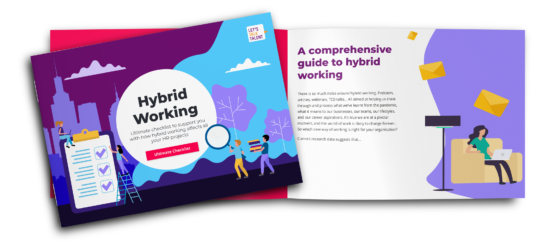Our 5 tips to getting great people and keeping great people within your business
The job market has changed almost overnight. With the arrival of vaccines and restrictions being lifted, thoughts of hunkering down until the storm has passed are no longer prevailing and candidates in all industries are exploring their options. So get prepared to think broader than the usual routes to market as talent recruitment may need a makeover.
According to research, UK-wide vacancies have surged by 16% in the first quarter of 2021 as “(…) pent-up demand from businesses and professionals waiting until more certain times to make moves has now been unleashed.” Sounds great for the market right? If you are an employee looking for a new challenge or a better-suited role, sure. If you are an employer trying to keep hold of your skilled workforce, not so much. Hiring and retaining staff is becoming a significant challenge for businesses. With candidates receiving multiple offers and current employees being poached for 10, 15 or 20 thousand pounds more than they are currently earning, companies are having to take part in a wage war that not many can afford to win.
So what can businesses do to get and keep great people in this kind of economy? Those who know us will know that at Let’s Talk Talent, we’re all about making a simple, practical plan and sticking to it. And this is no different. Because salary alone isn’t the be-all and end-all for many people. Making sure you understand why employees love to work for you can go a long way towards creating the kind of culture staff will want to be a part of.
The Great Resignation
The current recruitment market was generated by many factors, all working together to create the perfect storm. Pandemic panic and remote settings sometimes bringing out the worst in some leaders, learning and development (L&D) budgets being cut, people feeling like their career is stagnating, organisations forcing staff back into the office when they’ve gotten used to a better work-life balance… All elements that have made people rethink their jobs and careers over the last few months and led to the high resignation levels we’re seeing today. COVID-19 and the ensuing lockdown were all about surviving and hitting the numbers, and employees who felt like their careers took a backseat are now ready to start focusing on their professional development again.
In April 2021 alone, the US saw a record four million workers quit their jobs. And the impact of what is now called The Great Resignation isn’t just felt by employers scrambling to fill up the skills gaps. Those who left behind are also struggling, with hugely increased workloads often leading to more departures as those working themselves sick are in turn abandoning ship or going on extended leave. With the market in such a state, businesses are in danger of spinning out of control to try and keep afloat.
Going back to workforce planning
“The only way to succeed is to be clever and remove yourself from that spiral.” says Jo Taylor, MD at Let’s Talk Talent. “It’s all about making a plan and going back to your business strategy and workforce planning.” Here are a few tips to put this into practice and remove yourself from the kind of panic recruiting that can lead to long-term damage to both your people and your organisation.
Tip 1: Make a plan
Go back to your business strategy. Where do you want to be in five years’ time? Which key roles will you need to create or fill in order to get there? Are there any skill gaps in your current team? Creating a succession plan will allow you to have a clear, unbiased view of who you’ve currently got on your bench, and which skills are missing from your lineup based on where you want to be. Mapping out the roles you need in the short and long-term will help you streamline your recruitment process and focus on the candidates who will be truly instrumental in helping you get there.
Tip 2: Review your recruitment process
Once you know who you need to hire, take this opportunity to review your entire recruitment process. Is any part of it putting people off? Are you seeing drop offs at key stages? Are you forgetting about some talent sources you aren’t currently utilising due to unconscious bias? Or maybe some elements of your Employer Value Proposition (EVP) make it unattractive for key demographics to come work with you? For example, expecting employees to be physically in the office full-time or scheduling interviews during the school runs could be enough to put some parents off joining your team.
Tip 3: Focus on organisational development
Whilst external talent is a big part of filling skills gaps, don’t forget about internal employees. Make sure you invest in the people who are already dedicated to you and make them feel engaged and motivated about the future. An organisation is like an ecosystem; introducing a few new external factors will generate growth and change through adaptation. Taking over completely is another story. A healthy mix of recruitment and internal career development is the way to go in order to future-proof your business.
Tip 4: Don’t forget about internal job moves
As roles are left empty, many will want to fill key positions by promoting from below and thus following the traditional upwards trajectory. Which can be fine, as long as those employees do have the potential to step up to the plate, and you are able to offer them the kind of support they will need as they find their feet. But what about the rest of the team? Promoting up also means only one person can progress, and waiting for the seat to be free could be years away, during which time staff could very well get bored and leave. So, how do you retain key team members? Offer them more money to wait around?
You’ll have guessed, not our favourite option. We are firm believers in helping people develop, whichever direction that development takes them. Careers are not linear, they can take twists and turns and there are many ways to learn and be challenged. Instead of focusing only on money, focus on identifying new opportunities for your high potential talent to progress professionally. This could be through lateral movement such as secondments or new projects, internal mobility or mentoring programs. Make sure you have quality career conversations with your people so you can identify the right move for each of them.
Tip 5: Adopt a talent scout mentality
Maintaining a healthy workforce whilst the market is on fire requires both build and buy strategies. We like to think of it as being a talent scout for your organisation. Your role as a recruiter is to spot talent, hire the right players for your team and, during their time with you, give them the tools they need to fully unlock their potential. All whilst keeping an eye out for other new recruits who may be a good fit for your team. Unfortunately this also means that you’ll lose a few players from time to time. If it’s time for them to move on, make sure you help them through that transition. Talent is always on loan and helping them grow and develop may mean they will eventually leave for bigger and better things.
Conclusions
Getting great people and keeping great people during a talent shortage is not easy, we’ll give you that. Employers are sometimes having to move extremely quickly to secure great candidates. But being impatient, panicking or jumping on the bandwagon will not help in the long-term. Whatever the market is like, there are no shortcuts and employers will need to do their homework in order to figure out the skills they will need to reach their organisational objectives. So ensure your business and people strategies are well aligned, focus on the skills you really need, help your people develop internally and create enough lateral opportunities to keep your current workforce motivated and energised.
If you’re struggling to recruit or retain staff and would like some advice on how to make it easier and stand out from the competition, give us a call. We can definitely help you get further ahead.

